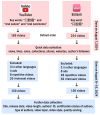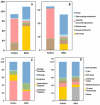YouTube and Bilibili as sources of information on oral cancer: cross-sectional content analysis study
- PMID: 40593960
- PMCID: PMC12214728
- DOI: 10.1038/s41598-025-02898-9
YouTube and Bilibili as sources of information on oral cancer: cross-sectional content analysis study
Abstract
This study aims to evaluate the informational quality of oral cancer-related videos on YouTube and Bilibili. A total of 300 oral videos that met the inclusion and exclusion criteria were selected for analysis. The selection comprised 150 videos from 111 uploaders on YouTube and 150 videos from 134 uploaders on Bilibili. YouTube videos received a greater number of views and likes, while there was no significant difference in average likes per 30 days or comments between the two platforms. The majority of YouTube uploaders were hospitals/non-profit organizations (66.7%) and for-profit companies (17.1%), while Bilibili uploaders were mainly self-media (55.2%) and doctors (29.1%). YouTube videos covered a broader range of topics compared to Bilibili videos. Though solo narration was the most prevalent video style across both platforms, YouTube exhibited a higher preference for TV shows/documentaries (31.3%). Video quality was assessed using the four tools: Though mDISCERN (modified DISCERN) and PEMAT-Actionability (Patient Education Materials Assessment Tool) were similar across platforms, YouTube videos scored higher on PEMAT-Understandability, VIQI (Video Information and Quality Index), and GQS (Global Quality Score) in comparison to Bilibili videos. Videos produced by health professionals were considered more reliable. Spearman correlation analysis revealed no strong relationships between video quality and audience interaction. In conclusion, YouTube videos exhibited higher audience engagement and video quality, yet improvements are needed on both platforms. In order to promote high-quality health information, it is essential to encourage the development of more professional content creators and to optimize platform algorithms.
Keywords: Information quality; Oral cancer; Patient education; Public education; Public health; Social media.
© 2025. The Author(s).
Conflict of interest statement
Declarations. Competing interests: The authors declare no competing interests. Ethics approval and consent to participate: All information was obtained from publicly released YouTube and Bilibili, and none of the data involved personal privacy concerns. Therefore, no ethics or consent was needed.
Figures
Similar articles
-
Quality and Dissemination of Uterine Fibroid Health Information on TikTok and Bilibili: Cross-Sectional Study.JMIR Form Res. 2025 Aug 1;9:e75120. doi: 10.2196/75120. JMIR Form Res. 2025. PMID: 40749219 Free PMC article.
-
YouTube/ Bilibili/ TikTok videos as sources of medical information on laryngeal carcinoma: cross-sectional content analysis study.BMC Public Health. 2024 Jun 14;24(1):1594. doi: 10.1186/s12889-024-19077-6. BMC Public Health. 2024. PMID: 38877432 Free PMC article.
-
Information quality of videos related to esophageal cancer on tiktok, kwai, and bilibili: a cross-sectional study.BMC Public Health. 2025 Jul 2;25(1):2245. doi: 10.1186/s12889-025-23475-9. BMC Public Health. 2025. PMID: 40604838 Free PMC article.
-
Content quality and reliability of YouTube videos on oral appliance therapy for obstructive sleep apnea: A systematic analysis.Spec Care Dentist. 2024 Sep;44(5):1307-1316. doi: 10.1111/scd.12995. Epub 2024 Mar 22. Spec Care Dentist. 2024. PMID: 38520058
-
YouTube as an information source for femoroacetabular impingement: a systematic review of video content.Arthroscopy. 2015 Jan;31(1):136-42. doi: 10.1016/j.arthro.2014.06.009. Epub 2014 Aug 20. Arthroscopy. 2015. PMID: 25150406
References
-
- Miranda-Filho, A. & Bray, F. Global patterns and trends in cancers of the lip, tongue and mouth. Oral Oncol.102, 104551 (2020). - PubMed
-
- Jehn, P. et al. Postoperative quality of life and therapy-related impairments of oral cancer in relation to time-distance since treatment. J. Cancer Surviv. Res Pract.16, 1366–1378 (2022). - PubMed
MeSH terms
LinkOut - more resources
Full Text Sources
Medical
Miscellaneous



